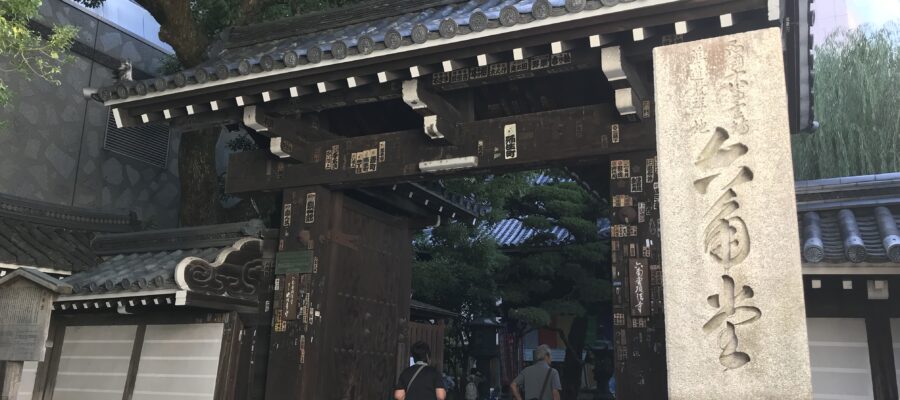親鸞聖人の百日参り
「六角さん」の名称で親しまれる 紫雲山 六角堂頂法寺(単立)は、西国三十三霊場の第18番。御本尊は聖徳太子の護持仏といわれる如意輪観世音菩薩様。ここには親鸞聖人が毎夜比叡山から百日参りをされ、夢のお告げにより浄土真宗を開いたとも伝わります。
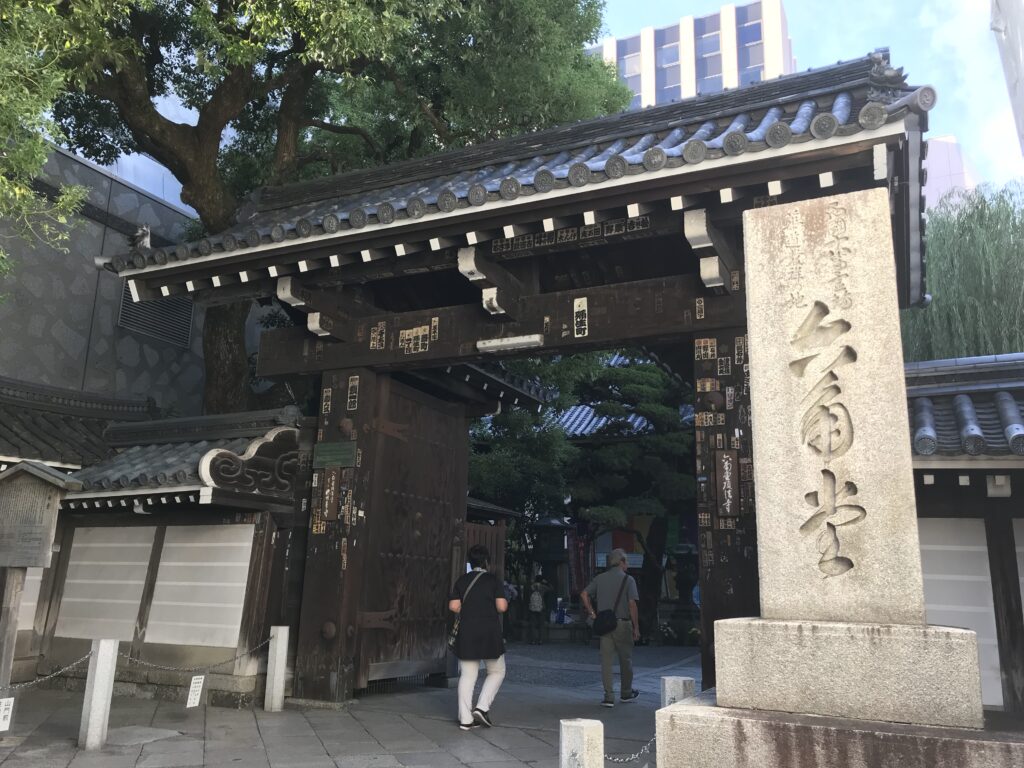
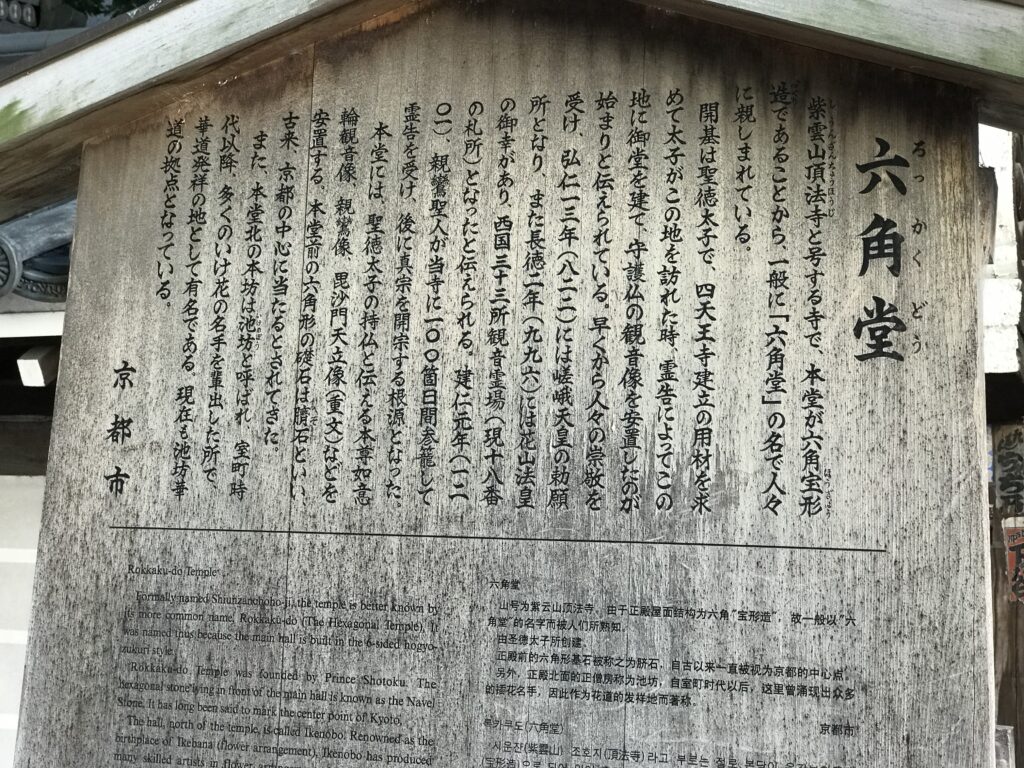
海外からのお客様を錦市場にご案内することが時々あります。その時は、バスを烏丸通りで停車してもらい、すぐ横の六角堂で仏教寺院のご案内をしてから錦に向かうこともあります。境内では六角堂の比率が大きすぎて、六角のイメージがつきにくいかもしれません。
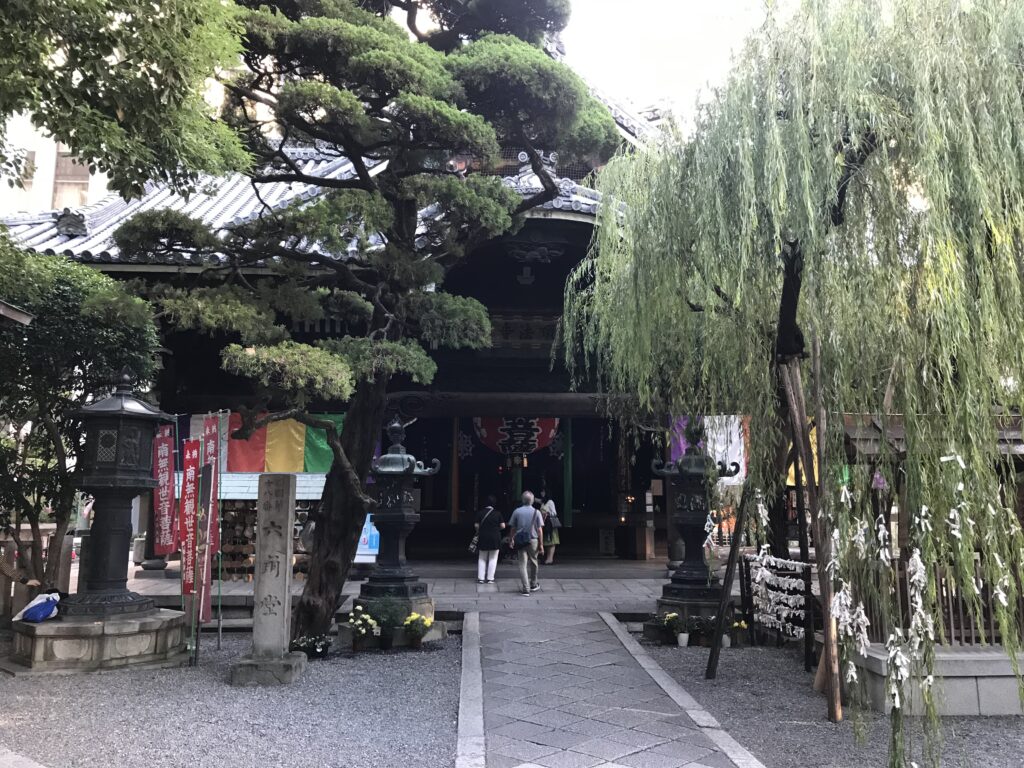
生け花の発祥の地
お寺によると、太子の教えに従い、小野妹子が朝夕宝前に花を供え、代々の住職がこれを伝えいけ花の名手が輩出しました。よって生け花の発祥の地と呼ばれます。池のほとりに住持の寺坊があったことから「池坊」と呼ばれるそうです。
そういえば、この周辺には単なる観光客とは思えない外国人が多くいました。華道家元池坊総務所やいけばな資料館もあるので、そちらの方に来られていたのかもしれません。華道も世界に広がった日本文化ですから、海外で学ぶ多くの方が訪問しに来るのでしょう。
十六羅漢
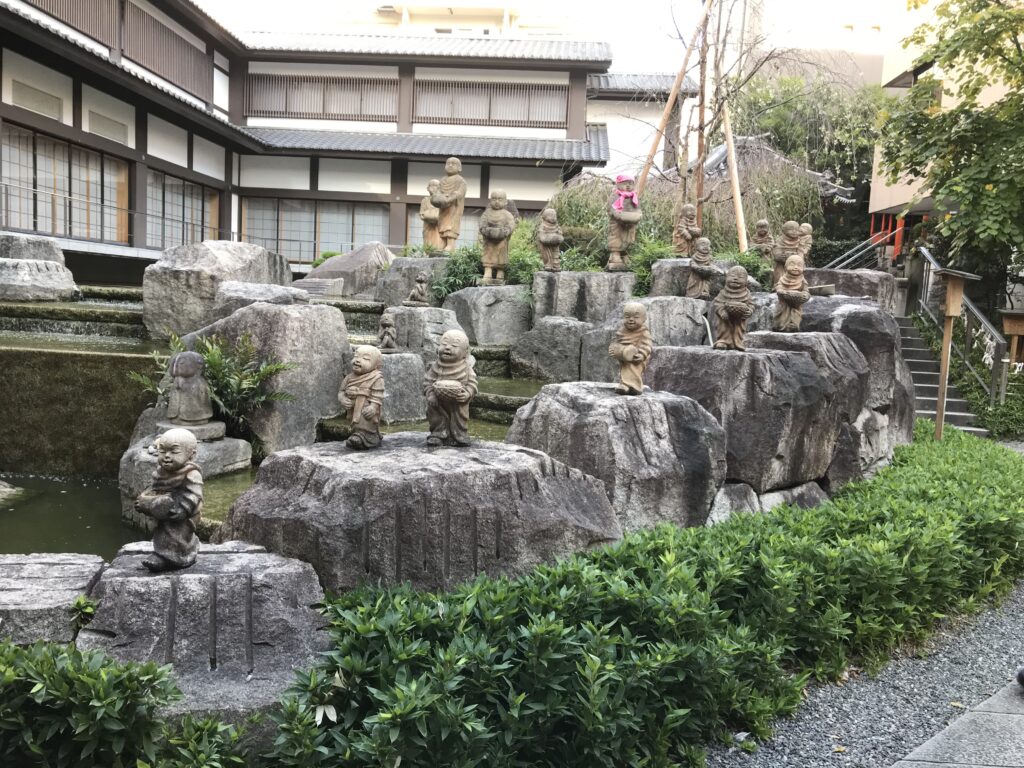
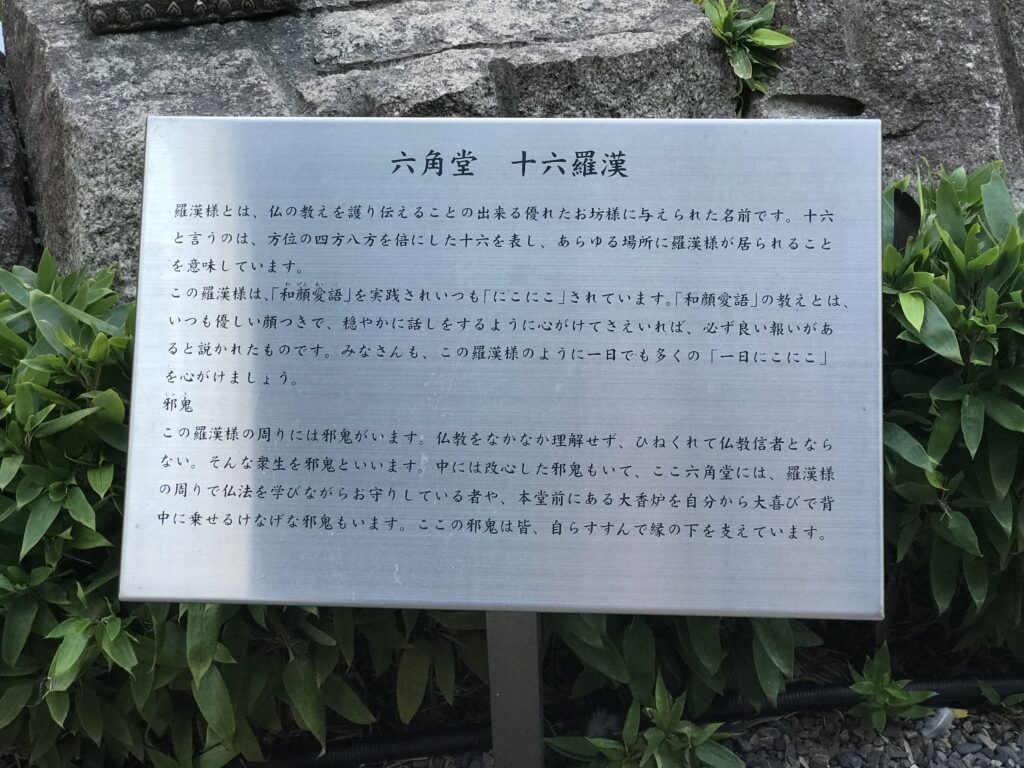
お堂のとなりに「和顔愛語」を実践していつもニコニコしている十六羅漢様がいらっしゃいます。皆、似たような顔に見えますが、ゆっくり見るとそれぞれ個性があり、にこやかにされています。最初はお地蔵様かなと思いました。(完)
六角堂の御朱印
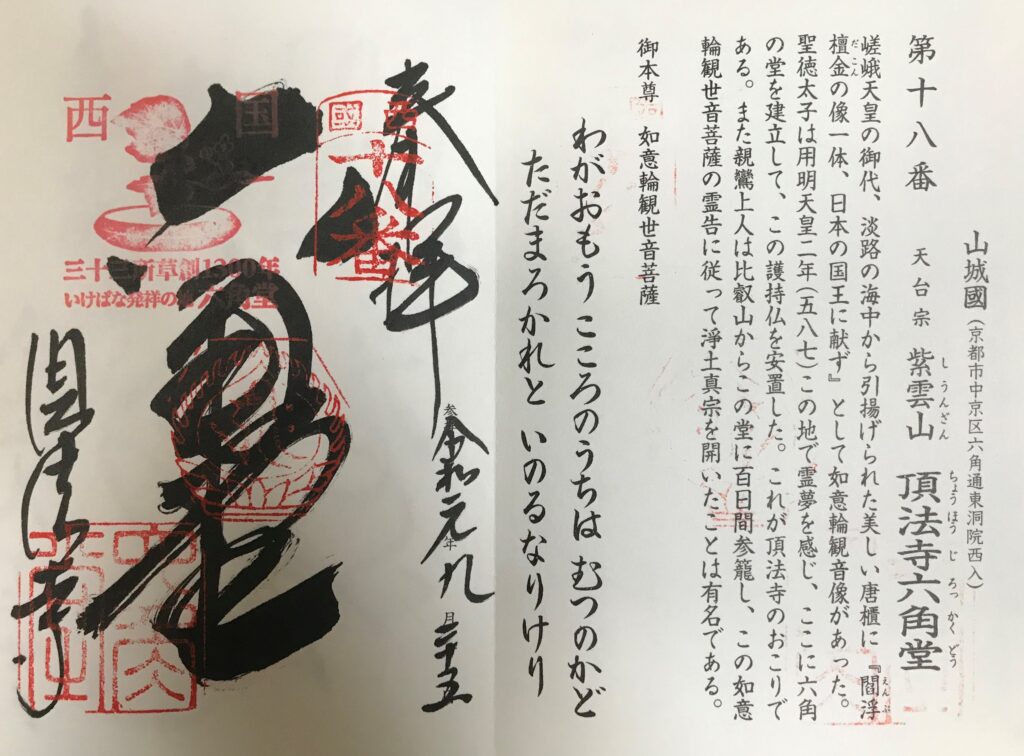
六角堂が紹介されている書籍
京阪神エルマガジン社が発行している「西国三十三所をめぐる本」に西国霊場が紹介されています。価格のわりに情報量、カラー写真ともに豊富で、お値打ちな一冊です。
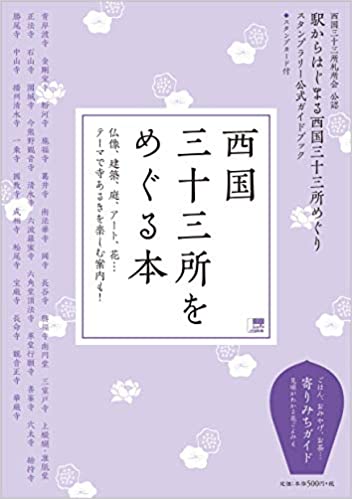
西国三十三所をめぐる本 駅からはじまる西国三十三所めぐりスタンプラリー公式 [ 京阪神エルマガジン社 ]
価格:550円
(2021/6/11 09:48時点)
感想(32件)
Rokkakudo Temple (English)
Buddhist priest Shinran Shonin’s 100 days visit
Shiunsan Rokkakudo Chohoji Temple, popularly known as Rokkaku-san, is the 18th of the 33 sacred sites in the western Japan. The main deity of the temple is Nyoirin Kanzeon Bosatsu, which is said to be the guardian Buddha of Prince Shotoku. It is said that Buddhist priest Shinran Shonin visited this temple every night for 100 days from Mount Hiei, and founded the Jodo Shinshu sect based on a dream.
Sometimes I take visitors from overseas to Nishiki Market. At that time, I sometimes ask the bus to stop at Karasuma-dori and give them a tour of the Buddhist temple at Rokkakudo right next to it before heading to Nishiki Market. The proportions of Rokkakudo main building is so large in the precincts that it may be difficult to get an idea of what Rokkakudo is.
Birthplace of Ikebana (Japanese flower arrangement)
According to the temple, following the teachings of Prince Shotoku, Ono-no-Imoko offered flowers in front of the treasure every morning and evening, and successive generations of priests passed this custom on to the next generation. This custom made the master of ikebana artists. This is why the temple is called the birthplace of ikebana. It is said that the name “Ikenobo” comes from the fact that the abbot’s temple was located by the pond. (Ike means Pond and Bo means abbot in Japanese)
Come to think of it, there were a lot of foreigners in the area, who I don’t think were just tourists. There is also the Ikenobo General Affairs Office of the Iemoto School of Ikebana and the Ikebana Museum, so they may have been visiting those places. Since flower arrangement is a part of Japanese culture that has spread to the rest of the world, many people who study flower arrangement overseas come to visit.
Sixteen Rohan
Next to the hall, there are sixteen arhats who are always smiling and practicing “Wa-gao-ai-go (Smiling face and Lovely words)”. They all look alike, but if you look at them slowly, you will see that each one has its own personality and is always smiling.At first, I thought they were Jizo Bodhisattvas.
Temple Rokkakudo (Français)
Visite de 100 jours du prêtre bouddhiste Shinran Shonin
Le temple Shiunsan Rokkakudo Chohoji, plus connu sous le nom de Rokkaku-san, est le 18e des 33 sites sacrés de l’ouest du Japon. La principale divinité du temple est Nyoirin Kanzeon Bosatsu, qui serait le Bouddha gardien du prince Shotoku. On dit que le prêtre bouddhiste Shinran Shonin a visité ce temple toutes les nuits pendant 100 jours depuis le Mont Hiei, et qu’il a fondé la secte Jodo Shinshu sur la base d’un rêve.
J’emmène parfois des visiteurs étrangers au marché de Nishiki. À ce moment-là, je demande parfois au bus de s’arrêter à Karasuma-dori et je leur fais visiter le temple bouddhiste de Rokkakudo, juste à côté, avant de me rendre au marché Nishiki. Les proportions du bâtiment principal de Rokkakudo sont si grandes dans l’enceinte qu’il peut être difficile de se faire une idée de ce qu’est Rokkakudo.
Lieu de naissance de l’Ikebana (arrangement floral japonais)
Selon le temple, suivant les enseignements du prince Shotoku, Ono-no-Imoko offrait des fleurs devant le trésor chaque matin et chaque soir, et les générations successives de prêtres ont transmis cette coutume à la génération suivante. Cette coutume a fait du maître des artistes ikebana. C’est pourquoi le temple est appelé le lieu de naissance de l’ikebana. On dit que le nom “Ikenobo” vient du fait que le temple de l’abbé était situé près de l’étang. (Ike signifie étang et Bo signifie abbé en japonais)
En y réfléchissant, il y avait beaucoup d’étrangers dans la région, qui, je pense, n’étaient pas de simples touristes. Il y a aussi le bureau des affaires générales d’Ikenobo de l’école d’Ikebana Iemoto et le musée de l’Ikebana, ils ont donc pu visiter ces endroits. Comme la composition florale est une partie de la culture japonaise qui s’est répandue dans le reste du monde, de nombreuses personnes qui étudient la composition florale à l’étranger viennent nous rendre visite.
Seize Rohan
À côté de la salle, il y a seize arhats qui sont toujours souriants et pratiquent le “Wa-gao-ai-go (Visage souriant et paroles aimables)”. Ils se ressemblent tous, mais si vous les regardez lentement, vous verrez que chacun a sa propre personnalité et est toujours souriant. Au début, je pensais qu’il s’agissait de bodhisattvas Jizo.
